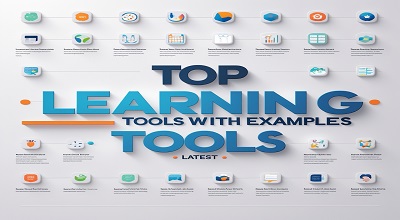Top Learning Analytics Tools
Top Learning Analytics Tools: Learning analytics refers to the measurement, collection, analysis, and reporting of data about learners and their interactions with educational content. It helps educators and institutions understand learning behaviors, predict performance, and personalize instruction. With advancements in AI and big data, learning analytics tools have become essential for modern education.
Importance of Learning Analytics
Learning analytics plays a crucial role in:
- Personalized Learning: Adapting content based on student needs.
- Early Intervention: Identifying at-risk students before they fall behind.
- Curriculum Improvement: Analyzing course effectiveness.
- Institutional Decision-Making: Enhancing administrative strategies.
- Engagement Tracking: Monitoring student participation.
Key Features of Learning Analytics Tools
The best learning analytics tools offer:
✔ Real-time Data Tracking
✔ Predictive Analytics
✔ Customizable Dashboards
✔ Integration with LMS
✔ Automated Reporting
✔ AI-Driven Insights
Top Learning Analytics Tools with Examples
Google Analytics for Education
Overview: Google Analytics helps track website and e-learning platform interactions.
Example: A university uses it to monitor student engagement with online resources.
Key Features:
- Traffic analysis
- Behavior flow tracking
- Custom reports
Moodle Learning Analytics
Overview: Built into Moodle LMS, it provides predictive insights.
Example: Teachers identify students likely to drop out based on activity logs.
Key Features:
- Risk prediction models
- Customizable rules
- Activity completion tracking
Blackboard Analytics
Overview: Blackboard offers deep insights into student performance.
Example: Institutions analyze course effectiveness and student success rates.
Key Features:
- Performance benchmarking
- Retention analytics
- Integration with Blackboard Learn
Tableau for Education
Overview: A powerful data visualization tool for educational insights.
Example: Schools create interactive dashboards to track enrollment trends.
Key Features:
- Drag-and-drop analytics
- Real-time data visualization
- Multi-source data integration
SAS Visual Analytics
Overview: SAS provides AI-powered analytics for education.
Example: Universities predict student success using historical data.
Key Features:
- Machine learning models
- Automated forecasting
- Interactive reports
Power BI for Learning Insights
Overview: Microsoft’s Power BI helps visualize educational data.
Example: Teachers track student progress through interactive dashboards.
Key Features:
- Customizable reports
- AI-driven insights
- Cloud-based analytics
Brightspace Analytics
Overview: D2L’s Brightspace offers robust learning analytics.
Example: Institutions measure course engagement and adjust teaching methods.
Key Features:
- Competency tracking
- Engagement metrics
- Personalized learning paths
Canvas Analytics
Overview: Instructure’s Canvas provides detailed course analytics.
Example: Educators analyze quiz performance to improve assessments.
Key Features:
- Grade prediction
- Student activity reports
- LMS integration
IBM Watson Education
Overview: AI-powered analytics for personalized learning.
Example: AI tutors adapt lessons based on student performance.
Key Features:
- Natural language processing
- Adaptive learning
- Cognitive tutoring
LearnDash Analytics
Overview: WordPress LMS plugin with built-in analytics.
Example: Online course creators track user progress and completion rates.
Key Features:
- Course progress tracking
- Quiz performance reports
- User engagement metrics
How to Choose the Right Learning Analytics Tool?
Consider:
- Compatibility with your LMS
- Ease of use
- Cost and scalability
- Data security
- Customer support
Future Trends in Learning Analytics
- AI & Machine Learning: More adaptive learning systems.
- Blockchain for Credentials: Secure and verifiable learning records.
- Emotion Analytics: Tracking student engagement via facial recognition.
- Augmented Reality (AR) Analytics: Analyzing AR-based learning interactions.
Conclusion
Learning analytics tools empower educators with actionable insights, improving student outcomes. From Google Analytics to AI-driven platforms like IBM Watson, institutions can leverage data to enhance teaching strategies.
FAQs
Q1: What is the best free learning analytics tool?
A: Google Analytics and Moodle Learning Analytics offer free versions with robust features.
Q2: How does AI improve learning analytics?
A: AI enables predictive modeling, personalized recommendations, and automated insights.
Q3: Can learning analytics replace teachers?
A: No, it supports teachers by providing data-driven insights for better decision-making.
Q4: Is data privacy a concern in learning analytics?
A: Yes, institutions must comply with GDPR and FERPA to protect student data.
Q5: Which tool is best for K-12 schools?
A: Brightspace Analytics and Power BI are user-friendly options for K-12 institutions.
Free Link: Parallel Space Lite 32 Support APK
